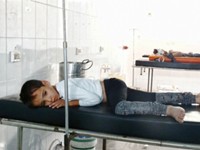Advertisement
Grab your lab coat. Let's get started
Welcome!
Welcome!
Create an account below to get 6 C&EN articles per month, receive newsletters and more - all free.
It seems this is your first time logging in online. Please enter the following information to continue.
As an ACS member you automatically get access to this site. All we need is few more details to create your reading experience.
Not you? Sign in with a different account.
Not you? Sign in with a different account.
ERROR 1
ERROR 1
ERROR 2
ERROR 2
ERROR 2
ERROR 2
ERROR 2
Password and Confirm password must match.
If you have an ACS member number, please enter it here so we can link this account to your membership. (optional)
ERROR 2
ACS values your privacy. By submitting your information, you are gaining access to C&EN and subscribing to our weekly newsletter. We use the information you provide to make your reading experience better, and we will never sell your data to third party members.
Environment
Former Foes To Collaborate On Agent Orange Site Remediation
Dioxin: U.S., Vietnam start cleanup of former military base near Da Nang
by Glenn Hess
August 17, 2012
| A version of this story appeared in
Volume 90, Issue 34
Nearly four decades after the end of the Vietnam War, the U.S. and Vietnam have begun a joint cleanup operation at Da Nang International Airport, the site of a former U.S. military base that remains contaminated with dioxin.
“This morning we celebrate a milestone in our bilateral relationship,” U.S. Ambassador to Vietnam David B. Shear said at a ceremony earlier this month attended by senior officers of the Vietnamese military. “We’re cleaning up this mess.”
The airfield was used by the U.S. military to store barrels of Agent Orange, a mixture of (2,4-dichlorophenoxy)acetic acid and (2,4,5-trichlorophenoxy)acetic acid that was sprayed on vegetation used as cover by guerrilla forces. The 2,4,5-T used in the defoliant was later discovered to be contaminated with 2,3,7,8-tetrachlorodibenzo-p-dioxin (TCDD), a toxic compound that has been linked to birth defects and cancers and other diseases.
More than two dozen former U.S. military bases have been referred to as “hot spots” by the Vietnamese government because of the dioxin concentrations remaining in the soil at these sites.
At Da Nang, 73,000 m3 of soil around the airport will be excavated and treated with thermal desorption technology.
“This process uses high temperatures to break down the dioxin in the contaminated soil and make it safe by Vietnamese and U.S. standards for the many men, women, and children who live and work in this area,” Shear remarked. The project is expected to be complete by 2016.



Join the conversation
Contact the reporter
Submit a Letter to the Editor for publication
Engage with us on Twitter